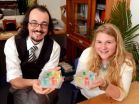(Press-News.org) Studying mouth cancer in mice, researchers have found a way to predict the aggressiveness of similar tumors in people, an early step toward a diagnostic test that could guide treatment, according to researchers at Washington University School of Medicine in St. Louis.
"All patients with advanced head and neck cancer get similar treatments," said Ravindra Uppaluri, MD, PhD, associate professor of otolaryngology. "We have patients who do well on standard combinations of surgery, radiation and chemotherapy, and patients who don't do so well. We're interested in finding out why."
Reporting in Clinical Cancer Research, the investigators found a consistent pattern of gene expression associated with tumor spreading in mice. Analyzing genetic data from human oral cancer samples, they also found this gene signature in people with aggressive metastatic tumors.
"We didn't automatically assume this mouse model would be relevant to human oral cancer," said Uppaluri, who performs head and neck surgeries at Barnes-Jewish Hospital. "But it turns out to be highly reflective of the disease in people."
Rather than use genetic methods to induce tumors in the mice, the research team repeatedly applied a known carcinogen, in much the same way humans develop cancer of the mouth.
"Patients often have a history of tobacco and alcohol use, which drive the development of these tumors," Uppaluri said. "We felt that exposing the mice to a carcinogen would be more likely to produce similar kinds of tumors."
The researchers, including first author Michael D. Onken, PhD, research assistant professor of cell biology and physiology, showed that this exposure sometimes produced tumors in the mice that did not spread, but other times resulted in aggressive metastatic tumors, similar to the variety of tumors seen in people. Uppaluri's team then collaborated with Elaine Mardis, PhD, co-director of The Genome Institute at Washington University, to find out whether the mouse and human tumors also were genetically similar. They compared their mouse sequences to human data sets from The Cancer Genome Atlas (TCGA).
"When we sequenced these tumors, we found that a lot of the genetic mutations present in the mouse tumors also were found in human head and neck cancers," Uppaluri said.
Further analysis identified a common signature in the expression of about 120 genes that was associated with the more aggressive tumors, whether in mice or people. The researchers confirmed this signature using data collected from 324 human patients. Subsequently, using oral cancer samples from patients treated at Washington University, they developed a proof of concept test from their signature that identified the aggressive tumors with about 93 percent accuracy.
Working with the Washington University Office of Technology Management, Uppaluri has a patent pending on this technology and recently received funding from the Siteman Cancer Frontier Fund to develop a laboratory test that predicts aggressive disease and would be easily available for any patient diagnosed with head and neck cancer.
"These kinds of tests are available for other types of cancer, most notably breast cancer," he said. "They are transformative genetic tests that can alter the clinical management of patients, tailoring therapies especially for them. It's our goal to develop something like that for head and neck cancer."
INFORMATION:
This work was supported by the National Cancer Institute (NCI), the National Human Genome Research Institute (NHGRI) and the National Institute of General Medical Sciences (NIGMS), all of the National Institutes of Health (NIH). Grant numbers 5U54HG003079, P30DC04665, P30 CA91842, ICTS/CTSA UL1TR000448, CA91842, R01GM38542.
Onken MD, Winkler AE, Kanchi KL, Chalivendra V, Law JH, Rickert CG, Kallogjeri D, Judd NP, Dunn GP, Piccirillo JF, Lewis Jr. JS, Mardis ER, Uppaluri R. A surprising cross-species conservation in the genomic landscape of mouse and human oral cancer identifies a transcriptional signature predicting metastatic disease. Clinical Cancer Research. June 1, 2014.
Washington University School of Medicine's 2,100 employed and volunteer faculty physicians also are the medical staff of Barnes-Jewish and St. Louis Children's hospitals. The School of Medicine is one of the leading medical research, teaching and patient-care institutions in the nation, currently ranked sixth in the nation by U.S. News & World Report. Through its affiliations with Barnes-Jewish and St. Louis Children's hospitals, the School of Medicine is linked to BJC HealthCare.
Researchers home in on way to predict aggressiveness of oral cancer
2014-06-26
ELSE PRESS RELEASES FROM THIS DATE:
Over-activity of enzyme HDAC6 exacerbates symptoms of Amyotrophic Lateral Sclerosis
2014-06-26
Scientists at VIB and KU Leuven have demonstrated in fruit-flies that over-activity of the enzyme HDAC6 in the nerve ends exacerbates the symptoms of the neurodegenerative condition Amyotrophic Lateral Sclerosis (ALS / Lou Gehrig's Disease). Inhibition of this enzyme could offer a protective effect against ALS.
Patrik Verstreken (VIB/KU Leuven): "Nobody wants to suffer from a degenerative condition such as amyotrophic lateral sclerosis (ALS), in which you lose coordination of all muscles through gradual damage to the nerve cells. ALS patients are conscious throughout ...
Organic agriculture boosts biodiversity on farmlands
2014-06-26
Organic farming fosters biodiversity. At least that's the theory. In practice, however, the number of habitats on the land plays an important role alongside the type and intensity of farming practices. These are the findings of an international study that looked at 10 regions in Europe and two in Africa. The results has been published in Nature Communications. The study shows that even organic farms have to actively support biodiversity by, for example, conserving different habitats on their holdings.
An international team, including participants from Technische Universität ...
We speak as we feel -- we feel as we speak
2014-06-26
A team of researchers headed by the Erfurt-based psychologist Prof. Ralf Rummer and the Cologne-based phoneticist Prof. Martine Grice has carried out some ground-breaking experiments to uncover the links between language and emotions. They were able to demonstrate that the articulation of vowels systematically influences our feelings and vice versa.
The research project looked at the question of whether and to what extent the meaning of words is linked to their sound. The specific focus of the project was on two special cases; the sound of the long 'i' vowel (/i:/) and ...
Rosin up that bow, maestro. And thank your genes
2014-06-26
EAST LANSING, Mich. --- Mom or dad may have driven you to cello rehearsal all those years, but you can also thank your genes for pushing you to practice, according to new research led by a Michigan State University professor.
Genetics and environment work together to help people become accomplished musicians, finds the study of 850 sets of twins. It's another arrow in the quiver of the argument that both nature and nurture play a role in developing expertise.
"The nature vs. nurture debate has raged since the beginning of psychology," said Zach Hambrick, MSU professor ...
Packing hundreds of sensors into a single optical fiber for use in harsh environments
2014-06-26
WASHINGTON, June 26, 2014—By fusing together the concepts of active fiber sensors and high-temperature fiber sensors, a team of researchers at the University of Pittsburgh has created an all-optical high-temperature sensor for gas flow measurements that operates at record-setting temperatures above 800 degrees Celsius.
This technology is expected to find industrial sensing applications in harsh environments ranging from deep geothermal drill cores to the interiors of nuclear reactors to the cold vacuum of space missions, and it may eventually be extended to many others.
The ...
NNI releases progress review on environmental, health, & safety research
2014-06-26
The National Nanotechnology Initiative (NNI) released today a Progress Review on the Coordinated Implementation of the National Nanotechnology Initiative 2011 Environmental, Health, and Safety Research Strategy, a document that demonstrates the wide range of research activities, accomplishments, and collaborations of Federal agencies working toward the responsible development of nanotechnology.
This document is a result of efforts by the Federal agencies participating in the Nanotechnology Environmental and Health Implications (NEHI) Working Group. NEHI is a Working Group ...
Capturing CO2 emissions needed to meet climate targets
2014-06-26
This is shown by the most comprehensive study to date on technology strategies to combat climate change, published in a special issue of the journal Climatic Change. It is based on the analysis of 18 computer models by an international team of scientists under the roof of the Stanford Energy Modelling Forum (EMF 27).
"Versatile technologies seem to be most important to keep costs in check," says lead author Elmar Kriegler from the Potsdam Institute for Climate Impact Research. Both bioenergy and CCS can help reduce emissions from non-electric energy use that would be ...
Does psychostimulant use increase cardiovascular risk in children with ADHD?
2014-06-26
New Rochelle, NY, June 26, 2014—Psychostimulant use to treat children and adolescents with attention-deficit/hyperactivity disorder (ADHD) is increasing worldwide, and the evaluation of the cardiovascular safety of stimulant medication used in treatment has been a recent topic of concern. The results of the first nationwide study of the cardiovascular safety of stimulants in children and adolescents are published in Journal of Child and Adolescent Psychopharmacology (JCAP), a peer-reviewed journal from Mary Ann Liebert, Inc., publishers. The article is available free on ...
Which interferons best control viral infections?
2014-06-26
New Rochelle, NY, June 26, 2014—Respiratory and intestinal infections caused by RNA viruses stimulate infected cells to produce interferons, which can act alone or in combination to block virus replication. Important differences between the presence of IFN receptors on cells and new evidence that specific types of IFNs can control RNA virus infection are explored in a Review article in Journal of Interferon & Cytokine Research (JICR), a peer-reviewed publication from Mary Ann Liebert, Inc., publishers. The article is available free on the JICR website.
In "Type-I and ...
Iowa State engineers turn LEGO bricks into a scientific tool to study plant growth
2014-06-26
AMES, Iowa – Ludovico Cademartiri had what seemed like an impossibly demanding list of requirements for his lab equipment.
The Iowa State University assistant professor of materials science and engineering wants to understand environmental effects on plant growth, specifically how variations in climate and soil characteristics affect root growth. That requires highly controlled environments that expose whole plants to environmental effects such as nutrients, water, oxygen gradients as well as physical obstacles for the roots.
Greenhouses can create fairly controlled ...





